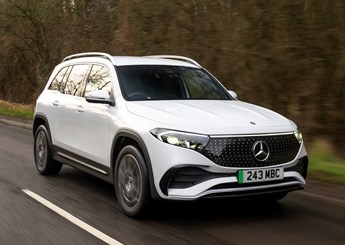We use cookies to ensure that we give you the best experience on our website. If you continue without changing your settings, we will assume that you are happy to receive all cookies on the Business Car website. However, if you would like to, you can change your cookies at any time

The start point for the best source of fleet information |
First drive: Mercedes-Benz EQB
Date: 25 April 2024 | Author: Sean Keywood

|
|
||||||||||||||||
As we know, the choice of available EV models on the market is ever-increasing. But what are your options if you want to combine electric power (and the associated 2% BIK company car tax rate) with seven seats? Well, these generally fall into two camps - van-derived models such as the Citroen Berlingo and Vauxhall Vivaro, or large SUVs such as the Volvo EX90 and Kia EV9. There is, however, an exception to these trends in the form of the Mercedes-Benz EQB. This SUV is closely related to Merc's smallest electric SUV, the EQA, but with an extended wheelbase, boxier styling and that practicality-boosting third row of seats. Like the EQA, the EQB was recently updated, and having reviewed the EQA last month, we're now getting to grips with the seven-seater alternative.
Facelift updates to the EQB (which closely resemble those made to the EQA) include a new star-pattern front grille, new-look headlights linked by an LED light band, new bumpers designed to provide improved aerodynamics, a new rear diffuser element, and new-look tail lights. Inside, there's the latest version of the MBUX infotainment system, and a new steering wheel. There's also, on specs including the mid-range AMG Line Executive tested here, new star-pattern interior trim, so there can be no forgetting you're driving a Mercedes. There is a good premium feel to the interior (despite fully-manual seat adjustment with this grade) with generally high-quality materials.
As for the EQB's seven-seat USP, how practical the third row of seats are really depends on the position of the sliding second row. If adults are sitting in the second row, only small children will be able to fit behind them, and if the second row is in its most rearward position then there is no third-row legroom at all. Also, when sitting in the third row you do feel fairly close to the rear window.
Having all the seats in use also limits boot space. Mercedes hasn't quoted a capacity figure in this arrangement, but with the third-row seats folded 495 litres is officially on offer - and it feels bigger than that thanks to the squared-off design.
One noteworthy addition to the facelifted EQB range is a new, entry-level 190hp motor option. This proved itself up to the job on our test drive, offering brisk and immediate acceleration (though we only tested the model one-up, so can't really speculate on how it might be with seven aboard). At 300 miles, official range is 23 miles down on the equivalent EQA - an entry-level EQB Sport Executive ups the model's figure to 321 miles.
Despite its C-segment origins the EQB feels like a big car from behind the wheel with its raised driving position and bonnet - whether that's a positive or negative we suppose will come down to personal taste.
The EQB does feel all of its weight (over 2.1t) and height when cornering, making its displeasure fairly clear at vigorous driving. It feels nose heavy and inclined to understeer, especially if power - which comes in very unsubtly if the Sport drive mode is selected - is applied in the middle of a bend. However, with a car like this, we imagine most will be more interested in ride comfort than handling, and it is impressively smooth at speed on major roads, though does tend to thud into potholes a bit around town. You are also pretty aware of camber changes on country lanes.
The EQB costs just over £3,000 more on P11D than the EQA - and that model already looks expensive compared with C-segment electric SUVs from the likes of BMW and Audi. However, the EQB does have that seven-seat trump card to play, which if you need it, could make all the difference.
Mercedes-Benz EQB 250+ AMG Line Executive
P11D: £55,005
Residual value: 36%
Depreciation: £34,650
Fuel: £3,856
Service, maintenance and repair: £1,969
Cost per mile: 67.45p
Range: 300 miles
CO2 (BIK %): 0g/km (2%)
BIK 20/40% a month: £18/£37
Luggage capacity: 495 litres (with third-row seats folded)
Battery size/power: 70.5kWh/190hp
Verdict |
7/10 |
|||
 |
|
 |
|
|











